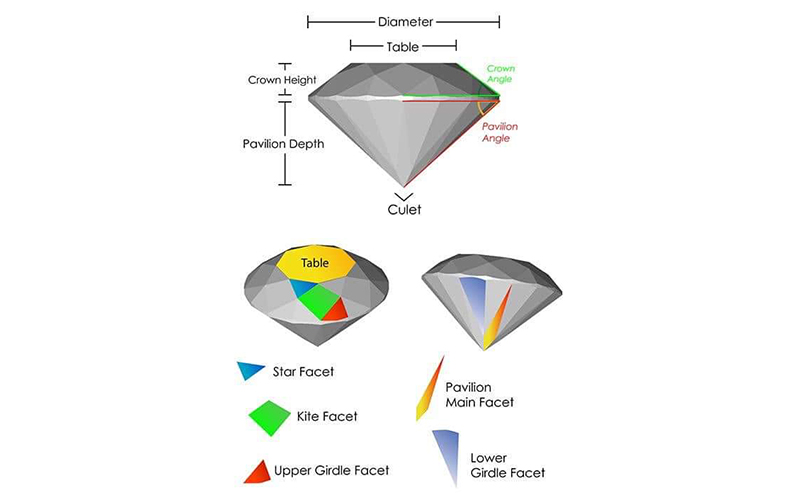Anatomy of Brilliance: A Guide to the Parts of a Round Cut Diamond
By Admin

The round cut diamond is a timeless and popular choice, known for its brilliance and fire. This refers to the way light interacts with the diamond's many facets, creating a dazzling display of sparkle and rainbow colors. Here's a breakdown of the different parts of a round cut diamond labeled in the image:
- Crown: The top part of the diamond, above the girdle. It includes the table, upper girdle facets, and the crown facets (including stars, half bezels, and bezels).
- Table: The flat, topmost facet of the diamond.
- Upper Girdle Facet: The narrow facet that encircles the crown, where the crown meets the girdle.
- Crown Facets: The triangular or kite-shaped facets on the upper part of the crown, including the stars (upper most facets), half bezels (middle facets), and bezels (facets closest to the girdle).
- Girdle: The thin band around the diamond's middle that separates the crown from the pavilion.
- Pavilion: The lower part of the diamond, below the girdle. It includes the culet, lower girdle facets, and the pavilion facets (including mains and halves).
- Culet: The tiny facet at the very bottom tip of the pavilion. It can be pointed or polished flat.
- Lower Girdle Facet: The narrow facet that encircles the pavilion, where the pavilion meets the girdle.
- Pavilion Facets: The triangular or kite-shaped facets on the lower part of the pavilion, including the mains (larger facets) and halves (smaller facets near the culet).
The proportions and arrangement of these parts play a big role in a diamond's brilliance, fire, scintillation ( flashes of light), and overall beauty. These qualities are influenced by factors such as:
- Cut Grade: A measure of how well a diamond's proportions, symmetry, and polish affect its light performance. A well-cut diamond will deliver optimal brilliance and fire.
- Depth: The distance from the table to the culet, relative to the diamond's diameter.
- Table Size: The size of the flat facet at the top of the diamond.
- Crown Height: The distance from the table to the girdle, relative to the diamond's diameter.
- Pavilion Depth: The distance from the girdle to the culet, relative to the diamond's diameter.
Understanding the anatomy of a round cut diamond can empower you to make informed decisions when choosing an engagement ring or other diamond jewelry.
